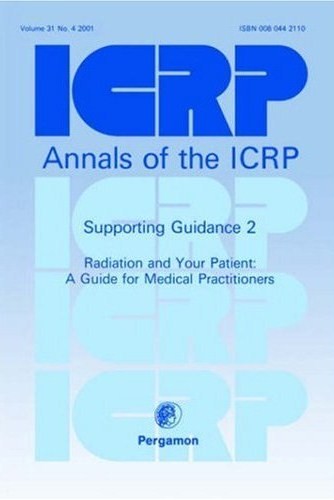ICRP Supporting Guidance 2
Radiation and your patient - A Guide for Medical Practitioners
Recommended citation
ICRP, 2001. Radiation and your patient - A Guide for Medical Practitioners. ICRP Supporting Guidance 2. Ann. ICRP 31 (4).
Abstract - This didactic text is devoted to the protection of patients against unnecessary exposure to ionising radiation. It is organised in a questions-and-answers format.
There are obvious benefits to health from medical uses of radiation, in x-ray diagnostics, interventional radiology, nuclear medicine, and radiotherapy. However, there are well-established risks from high doses of radiation (radiotherapy, interventional radiology), particularly if improperly applied, and possible deleterious effects from small radiation doses (such as those used in diagnostics). Appropriate use of large doses in radiotherapy prevents serious harm, but even low doses carry a risk that cannot be eliminated entirely. Diagnostic use of radiation requires therefore such methodology that would secure high diagnostic gains while minimising the possible harm.
For assessment of the risk, a quantitative measure of exposure is a necessary prerequisite. Therefore, dosimetric quantities are explained and defined (absorbed dose, effective dose). Basic facts are presented on mechanisms of action of ionising radiations on living matter. Undesired deleterious effects in man are categorised into two categories. The first one comprises sequelae resulting from massive cell killing (the so-called deterministic effects), requiring a high dose for their manifestation (exceeding the threshold dose). The second category includes those effects originating from mutational changes in the cellular DNA. These may eventually lead to development of radiation-induced cancer and to hereditary changes, transmitted to descendants of exposed individuals after irradiation of their gonads.
Data on the magnitude of threshold doses for cell killing effects are presented. On the basis of experimental, clinical, and epidemiological evidence, assessment is also given of the probability with which cancers and hereditary mutations may be induced by doses of various magnitudes, most likely without a threshold dose (below which no effect would obtain).
The text provides ample information on opportunities to minimise doses, and therefore the risk from diagnostic uses of radiation. This objective may be reached by avoiding unnecessary (unjustified) examinations, and by optimising the procedures applied both from the standpoint of diagnostic quality and in terms of reduction of the excessive doses to patients.
Optimisation of patient protection in radiotherapy must depend on maintaining sufficiently high doses to irradiated tumours, securing a high cure rate, while protecting the healthy tissues to the largest extent possible. Problems related to special protection of the embryo and fetus in the course of diagnostic and therapeutic uses of radiation are presented and practical solutions are recommended.
ICRP, 2001. Radiation and your patient - A Guide for Medical Practitioners. ICRP Supporting Guidance 2. Ann. ICRP 31 (4).
Abstract - This didactic text is devoted to the protection of patients against unnecessary exposure to ionising radiation. It is organised in a questions-and-answers format.
There are obvious benefits to health from medical uses of radiation, in x-ray diagnostics, interventional radiology, nuclear medicine, and radiotherapy. However, there are well-established risks from high doses of radiation (radiotherapy, interventional radiology), particularly if improperly applied, and possible deleterious effects from small radiation doses (such as those used in diagnostics). Appropriate use of large doses in radiotherapy prevents serious harm, but even low doses carry a risk that cannot be eliminated entirely. Diagnostic use of radiation requires therefore such methodology that would secure high diagnostic gains while minimising the possible harm.
For assessment of the risk, a quantitative measure of exposure is a necessary prerequisite. Therefore, dosimetric quantities are explained and defined (absorbed dose, effective dose). Basic facts are presented on mechanisms of action of ionising radiations on living matter. Undesired deleterious effects in man are categorised into two categories. The first one comprises sequelae resulting from massive cell killing (the so-called deterministic effects), requiring a high dose for their manifestation (exceeding the threshold dose). The second category includes those effects originating from mutational changes in the cellular DNA. These may eventually lead to development of radiation-induced cancer and to hereditary changes, transmitted to descendants of exposed individuals after irradiation of their gonads.
Data on the magnitude of threshold doses for cell killing effects are presented. On the basis of experimental, clinical, and epidemiological evidence, assessment is also given of the probability with which cancers and hereditary mutations may be induced by doses of various magnitudes, most likely without a threshold dose (below which no effect would obtain).
The text provides ample information on opportunities to minimise doses, and therefore the risk from diagnostic uses of radiation. This objective may be reached by avoiding unnecessary (unjustified) examinations, and by optimising the procedures applied both from the standpoint of diagnostic quality and in terms of reduction of the excessive doses to patients.
Optimisation of patient protection in radiotherapy must depend on maintaining sufficiently high doses to irradiated tumours, securing a high cure rate, while protecting the healthy tissues to the largest extent possible. Problems related to special protection of the embryo and fetus in the course of diagnostic and therapeutic uses of radiation are presented and practical solutions are recommended.
